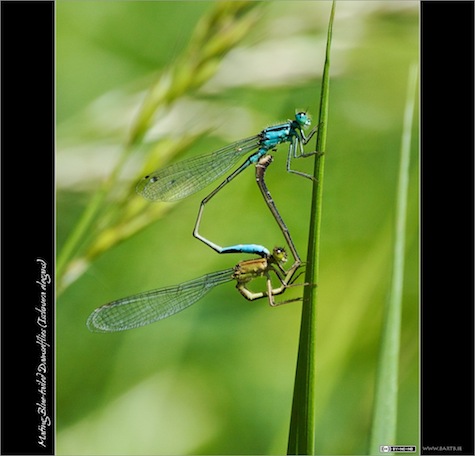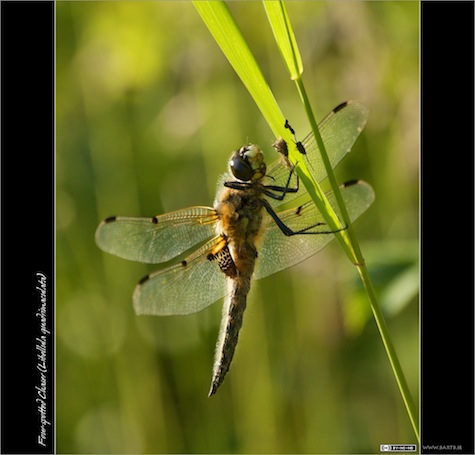Aug
24
Photo of the Week 130 & 131 – Two New Muses
Filed Under Photography on August 24, 2010 at 10:26 pm
For a long time now my two favourite subjects have been trains and butterflies, but this year I’ve started to be attracted by two related new muses. Butterflies are probably the most eye-catching insects in Ireland, but I think the largest are the Dragonflies and Damselflies that fill our summer skies. I’ve only been focusing on these guys for a few months, but I’ve already got some pictures I like enough to include here.
The first shot I’ve chosen shows a pair of Blue-tailed Damselflies (Ischnura elegans) making more Blue-tailed Damselflies. Two things to note here, firstly, Damselflies opt for a very unique position for mating, and the males and females have very different colours. Adult males of the different species generally look quite distinct (with a few exceptions), but many of the females of the different species look very similar, some species even have females of a few different colours, and to really confuse things, both males and females change colour as they mature. If you can’t recognise what species a Damselfly is, it’s probably a juvenile, or a female, or both. Butterflies are WAY easier to tell apart!
- Camera: Nikon D40
- Lens: Nikon DX AFS 55-200mm
- Exposure: 1/800 sec
- Focal Length: 200mm
- Focal Ratio: f/8
- ISO: 200
- Camera Mode: Aperture Priority
- Exposure Bias: -1.0ev
- Processing: tweaked a little using Aperture’s Dodge & Burn plugin
The second shot I chose is of the largest Dragonfly I’ve managed to capture so far, the Four-spotted Chaser (Libellula quadrimaculata). These guys are very territorial. They get their name because they chase away other Dragonflies that stray into their patch (and have 4 spots on each set of wings). They like to sit on perches that give them a good view of their territory, and will keep returning to their favourite perches over and over again. This makes them a joy to photograph, if you miss the perfect shot the first time around, just wait a bit, and you’ll get another chance! The fact that they like a perch with a good view also means you tend to be able to get shots with nice clutter-free backgrounds too.
I’ve also started to experiment a lot with back-lighting in the last few months. As this shot demonstrates, it can work nicely on insects which tend to have transparent or semi-transparent bits for the light to shine through.
- Camera: Nikon D40
- Lens: Nikon DX AFS 55-200mm
- Exposure: 1/400 sec
- Focal Length: 200mm
- Focal Ratio: f/8
- ISO: 400
- Camera Mode: Aperture Priority
- Exposure Bias: -1.0ev
- Processing: tweaked a little using Aperture’s Dodge & Burn plugin









Bart I ove your blog and contributions to several podcasts I listen to. I can’t remember which podcast I heard you mention a 8 Point star brush you use in PSE8. Do you know where I can get the brush?
Hi Edward,
Apologies for the INSANELY slow reply to your question. Your message got lost amidst the spam in my moderation queue, and I just found it now when I was cleaning it out.
I’m not 100% sure if this is the brush I use, but it looks like it: http://giegie.deviantart.com/art/Stars-Brushes-86137088
If not, you’re bound to find one you like in this list: http://www.atulperx.com/photoshop/free-brushes/photoshop-star-brushes-35-high-quality-stars-pack/
Hope that helps,
Bart.